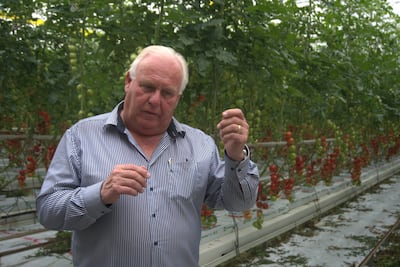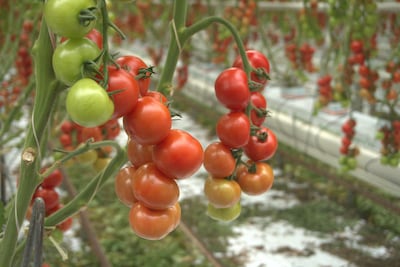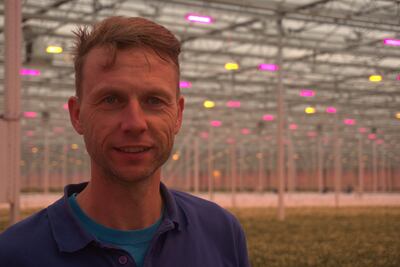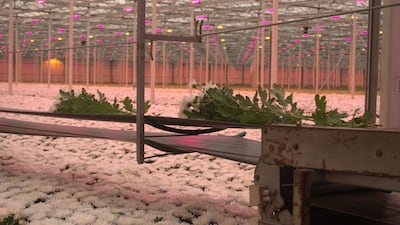Walking through rows of tightly coiled green and red grapevine tomatoes, Leo Van Der Lans explains how the family-owned greenhouse business grew in the past five decades to become one of the top five growers in the Netherlands.
That record of success has been put on hold after he made the unprecedented decision to switch off the lights in 80 per cent of his greenhouses this winter to reduce his energy use.
“The problem is that gas prices are incredibly high,” Mr Van Der Lans said. “They’ve gone from 15 to 20 cents a cubic metre to €1.60. That’s too much to grow tomatoes.”
With artificial lighting, tomatoes take eight weeks to grow during Dutch winters, but without extra light it can take them up to four months.
In some greenhouses, the Lans tomato company will also delay planting from September until December to avoid crippling gas bills, which have soared tenfold this year after Russia’s invasion in Ukraine.
It expects to reduce its gas use and tomato production by 25 per cent this year overall.
In the Dutch region of Westland, the heart of the country’s intensive horticulture production, Lans normally produces 40,000 tonnes of tomatoes a year and counts multinational retailers, such as Britain’s Tesco and Germany's Lidl, among its clients.
Royal Flower Holland
Its energy use strategy will be replicated by nearly half of the Netherlands producers of greenhouse fruit and vegetables, says Glastuinbouw Nederland, an association that represents 70 per cent of Dutch horticulture producers.
“You can only keep a growing schedule with fixed energy prices,” Glastuinbouw Nederland energy specialist Jean Aerts told The National.
A global powerhouse
This means that there will be fewer Dutch products — mostly tomatoes, bell peppers and cucumbers — in European supermarkets this winter.
Energy-hungry flowers grown in Dutch greenhouses, such as pot orchids, chrysanthemums and roses, will be similarly affected.
That may have a long-term effect on the country's decade-old model that was built on cheap gas supplies, experts say.
“We wait for better times,” Mr Van Der Lans said.

Despite its relatively small size, the Netherlands is a global powerhouse in fruit and vegetable production.
Figures shared by Fresh Produce Centre, which represents the interests of local businesses involved in the sale and marketing of fruit and vegetables, show that last year the Netherlands exported €13.1 billion ($12.83bn) worth of fruit and veg, and that 95 per cent of sales were to European countries.
At €1.7 million, tomatoes were the number one export. Top destinations included Belgium, the UK and France.
But exactly how much less of a choice European shoppers will have this winter depends on the weather in Southern Europe and North Africa.
Fruit and vegetables from Spain, Italy, Morocco and Tunisia traditionally increase their market share in winter and Dutch production goes down.
The opposite happens in summer as days grow longer and warmer in the Netherlands.
“Last winter, they had incredibly good weather for tomatoes,” Mr Van Der Lans said. “But if it freezes and there are no more tomatoes, you’ll see empty shops and higher prices.”
The effects of a bad Southern European winter would not be felt by consumers before next February, Mr Aerts said.
“There will certainly be an impact but we don’t expect a massive one,” he said.
Rising flower prices
Dutch flower growers, who represent 40 per cent of worldwide exports, are also being hard hit by the European energy crisis.
The number of producers who have decided to quit the market altogether has more than doubled this year compared to previous years.
Their departures have decreased by the equivalent of €100m the country's annual flower production, said Michel Van Schie, spokesman for Royal Flora Holland, a co-operative of 3,600 flower growers.
While the figure is minimal compared to the 2021 total turnover of €5.6bn, which was a record year because of Covid confinement, the rapid exit of producers will probably push prices up.
Unlike the fruit and vegetable sector, flower prices in the Netherlands are set in a daily auction and depend entirely on supply and demand.
Some flower producers are also expected to delay their planting season, but their exact number is unclear, Mr Van Schie said.

“They are still in the process of the current production,” he said. “It also depends on what others are doing. If one grower leaves the market, then there’s less flowers and prices will rise.”
Horticulture grew rapidly in the 1960s with cheap local gas, a model that is rapidly becoming unsustainable as extraction in the country’s gasfield in Groningen, one of the largest in the world, winds down because of destructive earthquakes.
Alternative energy supplies, such as geothermal heating, remain minimal.
At Mr Van Der Lans’s tomato producing company, it represents 10 per cent of total energy use, while the rest comes from natural gas. He hopes to take that figure up to 50 per cent by 2025.
“Game changer”
Energy prices in the coming years will define the future of Dutch greenhouses.
“This could be a game changer for the industry,” Mr Van Schie said. “Flowers are now produced the whole year round so you can buy any flower at any moment.
“Maybe it will lead to a situation where some flowers are not available in winter.”
Some producers are banking on innovation, hoping to stay ahead of the game.
In Westland, Wouter Duijvesteijn runs a company with his brother that produces 50,000 stems of white chrysanthemums a day, all year round.
Lights constantly change colour from red to blue in one of his greenhouses in the small town of Hoek van Holland, which give the leafy white flowers a flickering pink tinge.

“That’s the LED lights. They reduce our energy usage by 50 per cent,” Mr Duijvesteijn said.
Like many chrysanthemum producers, Mr Duijvesteijn has invested in a large energy system that runs on natural gas and produces electricity.
He resells power to national utility companies when prices are high and keeps the extra heat produced in the form of tanks of hot water. He also cleans the exhaust from the machine so that it can pump out carbon dioxide for the chrysanthemums.
In the company’s flower sorting room, where stems are packaged into neat bunches before being sent off to France, the UK and Eastern Europe, he has experimented with new insulation techniques on the walls with dried waste from chrysanthemums.
Mr Duijvesteijn has no plans to slow down work in the coming months and wants to power through the winter in the hope of benefitting from higher prices.
“The production is going down so fast now that we believe that prices will also be good,” he said.
Mr Duijvesteijn remains convinced that Dutch greenhouses will adapt thanks to new technology, and eventually wean themselves off gas.
“We’re constantly changing and evolving,” he said. “I’m sure that in five or 10 years we won’t use gas in greenhouses any more because we are more efficient than everybody else.”


